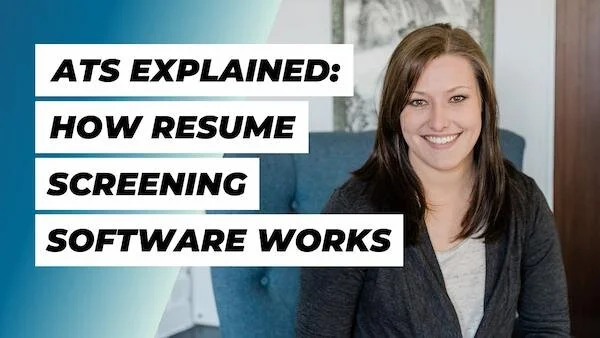ATS Explained: How Resume Screening Software Works
UNPOPULAR OPINION: The system isn't broken and ATS isn’t the problem... your resume writing skills are!
But it’s not your fault. The responsibility to learn how software—that you may never use in your own career or home—works on the back end falls on you, and there is a lot of misinformation being shared online. There are so many myths and misconceptions about how resume screening software works that I understand why you may think the system is broken.
Today, I'm breaking down how resume screening software works so that you can cut through all the noise online and start landing more interviews.
This blog contains affiliate links, meaning I may receive a small commission (at no cost to you) if you subscribe or buy something through the links I share. I only share links to products or services that I use myself or absolutely love!
Resume Screening Software 101
At the time I recorded this, the most recent statistic shared by Jobscan is that 98% of Fortune 500 companies use Applicant Tracking Systems or ATS.
Applicant Tracking Systems are software used by most mid-size to large companies and even used by small businesses to collect resumes and applications, store their information in a searchable profile within their database, and help recruiters and HR teams narrow down applicants to the most qualified candidates. They can do this by searching, sorting, filtering, and sometimes ranking applicants against each other based on the keywords found in their profile.
Getting Auto-rejected By ATS
ATS builds your profile in that company’s database using both your resume and application information. A common misconception is that ATS will eliminate applicants from consideration if certain keywords are missing from their resumes and automatically send a rejection email or message.
ATS doesn't auto-reject candidates because they're missing keywords in their resumes but can auto-reject a candidate who answered a knock-out question incorrectly if a recruiter sets the system to do so. Not all questions on an application are set as knock-out questions, and you won't be able to tell if a question is a knock-out question or not.
Knock-out questions are typically yes-or-no questions like, “Do you have 5 or more years of experience in sales?” If you answer no, but a yes is required, you may receive an automated rejection email or message because you don’t have one of the job requirements.
How ATS May Be Used By Recruiters
Think of ATS like a digital filing cabinet. Recruiters and HR teams use ATS to help organize open jobs, job postings, applicant information, and tasks for different stages of the hiring process. Your information is stored in this searchable database and can be found using search, sort, filter, and sometimes ranking features.
Recruiters and HR teams will most likely use specific qualifications, like a bachelor’s degree, and job-related skills, like sales, to search for and sort or filter applicants. In other words, you don’t need to add word-for-word every potential keyword you think is listed in a job posting to get in front of a recruiter. You just need to add the right keywords.
Again, these keywords are usually specific qualifications—degrees and certifications listed as required in the job posting—position titles—which means holding the role or a similar role previously helps immensely—and job-related skills and software skills listed in the job posting. Transferable skills like communication or problem solving likely won’t be used, but having strong examples of these skills in action will make a positive impact during a resume review.
ATS Ranking and Artificial Intelligence
Some ATS may rank you against other applicants and give recruiters and HR teams a match rate based on keywords and other criteria the recruiter has set. In these cases, it’s helpful to repeat keywords that align with the top job-related skills throughout your resume. The ATS may use artificial intelligence to identify where these keywords are located in your resume to determine your level of experience in certain areas.
Artificial intelligence may also be used to calculate your years of experience and even recommend other open jobs that you may be a better match for within that company.
Not All Resumes Can Be Seen By ATS
Heavily formatted and graphically designed resumes are often not scanned and stored correctly by ATS. Some ATS will convert what it reads into gibberish-looking code on a white page. If this happens, your profile will be incomplete and may not show up in search, sort, and filter results.
If the ATS uses ranking, it may still appear—depending on how many applicants there are—but with a very low or 0% match rate. You run the risk of recruiters not taking time to investigate if you’re so low beneath other qualified candidates in these results.
To make sure your resume doesn’t have any issues being scanned and is easy to view from your profile, upload a minimally-designed Word or PDF version of your resume. Avoid using columns or text boxes to organize your resume’s information since ATS will scan and read your resume from left to right and may store your searchable information incorrectly.
Avoid adding shapes, icons, graphs, charts, or tables to your resume—especially when using them to represent important details like skills or achievements. Only the text of your resume will be read and stored in your profile. They can also make it difficult for recruiters to view your resume from your profile.
Struggling to get through Applicant Tracking Software? These templates are designed to get through ATS and stand out in all the right ways when in front of hiring decision-makers
What your resume says about you matters.
As a Certified Resume Writer, my job is to create a resume that presents you as the best fit for the job that you want by aligning your career story with what recruiters and hiring decision-makers want to see - which is that you understand and can meet the goals of the role you’re pursuing as well as what value you bring to a team based on past performance.
If your resume isn’t conveying this information quickly, clearly, and effectively, I’d love to help!
You can sign up for my free 5-day Resume Rescue Challenge and discover the updates you can make to your resume today to start landing more interviews.
Author Profile: Steph Cartwright, CPRW
Steph Cartwright is a Certified Resume Writer, LinkedIn Strategist, and Founder of Off The Clock Resumes. She helps job seekers get unstuck and get a foot in the door at the companies they’d love to work for with their resumes, LinkedIn profiles, and job search plans.
What’s keeping you stuck in your job search? Take this quiz to find out…
What questions do you have about crafting, updating, or getting your resume through resume screening software?
Share your thoughts in a comment!









